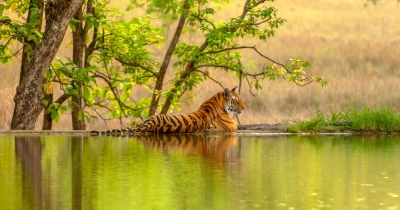
Spanning more than 1,500 sq km. the Ranthambore Tiger Reserve in Rajasthan comprises a national park of the same name and two sanctuaries – Sawai Mansingh and Keladevi Covered in grasslands and dense dry deciduous forests interspersed with rivulets and seasonal streams, small wonder it is home to over 200 species of birds and several reptiles, amphibians and mammals, with the tiger as its apex predator.
Wildlife
Francolins, quails, pochards, buttonquails, barbets, nightjars, cranes, sandgrouses, snipes, redshanks, sandpipers, jacanas, thickknees, stints, plovers, lapwings gulls, terns, buzzards, harriers, grebes, cormorants, bitterns, ibises, pelicans, storks, shrikes, minivets, drongos, flycatchers, thrushes, robins, bushchats, wheatears, mynas, starlings, tits, swallows, bulbuls, prinias, warblers, babblers, whitethroats, larks, sunbirds, wagtails, pipits, munias and buntings are found here. Tiger, leopard, jungle cat sloth bear wild boar, black buck, caracal jackal, fox, striped hyena mongoose, Indian wolf, chinkara, chital, otter, honey badger, pangolin, Asian palm civet, sambar, nilgai black- naped hare rhesus macaque and grey langur can be spotted here. Reptiles such as saltwater crocodile and mangrove monitor, and several species of snakes, including banded krait saw scaled viper and Indian cobra call the region home.
The big fight
The reserve is quite vast, spreading across more than 1,500 sq km. But this includes the more than 1,000 sq km of buffer 201, leaving the tigers with a little more than 500 sq km for use. However, since tigers are highly territorial and need a lot of room for themselves, Ranthambore faces an unusual problem – the problem of plenty. There are more than 70 tigers in the reserve, and each tiger is said to require about 10 sq km. forcing the big cats to fight for space. In the last few years, a few tigers have died in territorial fights. Not just that. When space becomes scarce, they venture out of their territory and into conflict – with humans. And most of these encounters do not end well for either. In the past a few tigers from Ranthambore have been relocated to other reserves such as Sariska. However, with the habitats of tigers shrinking, the tiger number is something to be watched closely.
The power of local knowledge
The forests of the reserve were earlier the hunting grounds of the kings. Today through villagers on the fringes the forests and its habitants are protected, says a media report Nearly 50 members of the Village Wildlife Volunteers programme not only protect and conserve the forests but also use their voice to rope in more people towards this cause. This has helped not just in the capture of poachers but also in keeping the forest department informed about the movement of tigers and the presence of other animals. Most invaluable is the knowledge of the villagers about local habitats and wildlife, which educates personnel in the department. For instance, the villagers helped discover “a breeding population of about 30 gharials, a critically endangered animal, in a river near Ranthambore”. They also assist researchers in the field. This story underscores how invaluable the role of locals in the protection of forest areas is.
Picture Credit : Google




